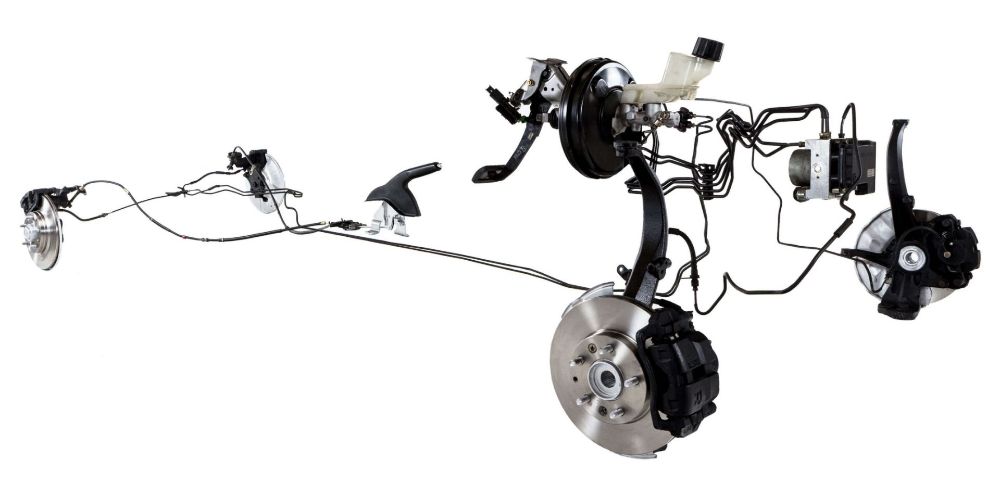Understanding Braking Systems in Cars: Keeping You Safe on the Road

Introduction:
Braking systems are an integral part of every car, ensuring the safety of drivers, passengers, and pedestrians alike. From drum brakes to hydraulic systems and regenerative brakes, this comprehensive guide will take you on a journey through the fascinating world of braking systems. So buckle up and let's dive in!
I. How does the braking system work in a car?
The braking system in a car is responsible for slowing down and stopping the vehicle when necessary. It works through a combination of mechanical and hydraulic principles. When you press the brake pedal, a series of actions take place:
-
Brake pedal activation:
When you apply pressure to the brake pedal, a rod or linkage transmits this force to the master cylinder. -
Master cylinder:
The master cylinder converts the mechanical force from the brake pedal into hydraulic pressure. -
Brake fluid:
The hydraulic pressure generated by the master cylinder is transmitted through brake lines filled with brake fluid. -
Brake calipers or wheel cylinders:
In disc brake systems, the brake fluid activates the calipers, which squeeze the brake pads onto the brake discs. In drum brake systems, the fluid pushes the wheel cylinders, causing the brake shoes to expand and press against the drum. -
Friction and heat:
The brake pads or shoes create friction against the rotating brake discs or drums, converting the kinetic energy of the car into heat energy. -
Slowing down or stopping:
The heat energy dissipated during braking slows down the vehicle until it comes to a complete stop.
II. Types of Braking Systems:
-
Drum Brakes:
- Description: Drum brakes are a common type of braking system used in older vehicles and the rear wheels of many modern cars.
- Key Features: They consist of brake shoes, brake drums, and wheel cylinders.
-
Disc Brakes:
- Description: Disc brakes are widely used in modern vehicles and are typically found on the front wheels.
- Key Features: They consist of brake calipers, brake pads, and brake discs.
-
Hydraulic Brakes:
- Description: Hydraulic brakes utilize fluid pressure to transfer force from the brake pedal to the braking mechanism.
- Key Features: They offer reliable and consistent braking performance.
III. Exploring Other Braking Components:
-
Parking Brake:
- Description: The parking brake, also known as the handbrake or emergency brake, is a secondary braking system used to keep the car stationary.
- Key Features: It is typically engaged by pulling a lever or pushing a button.
-
Anti-lock Brakes (ABS):
- Description: ABS prevents the wheels from locking up during emergency braking, allowing the driver to maintain control of the vehicle.
- Key Features: ABS rapidly modulates the brake pressure to each wheel.
-
Mechanical Brakes:
- Description: Mechanical brakes use mechanical force, such as a cable or linkage, to activate the braking system.
- Key Features: They are commonly found in bicycles and some older vehicles.
-
Regenerative Brakes:
- Description: Regenerative braking systems harness the kinetic energy of the moving vehicle and convert it into electrical energy.
- Key Features: They are commonly used in hybrid and electric vehicles.
-
Brake Hose:
- Description: Brake hoses are flexible tubes that carry brake fluid between various brake system components.
- Key Features: They need to be inspected regularly for signs of wear or damage.
-
Brake Master Cylinder:
- Description: The brake master cylinder is the heart of the hydraulic braking system, converting mechanical force into hydraulic pressure.
- Key Features: It contains a reservoir for brake fluid and pistons to generate hydraulic pressure.
FAQ Section:
Q: How does the braking system work in a car?
A: When you press the brake pedal, it activates the master cylinder, which converts the force into hydraulic pressure. This pressure is transmitted through brake lines to the brake calipers or wheel cylinders, which then engage the brake pads or shoes, creating friction against the discs or drums and ultimately slowing down or stopping the car.
Q: What are the 3 types of braking systems?
A: The three main types of braking systems are drum brakes, disc brakes, and hydraulic brakes.
Q: Do cars stop with all 4 brakes?
A: Yes, cars typically have brakes on all four wheels to ensure effective stopping power.
Q: Do cars brake with all 4 wheels?
A: Yes, when the brakes are engaged, all four wheels contribute to slowing down or stopping the car.
Q: Do cars have 2 or 4 brakes?
A: Cars have multiple braking components on each wheel, including brake pads or shoes, rotors or drums, calipers or wheel cylinders, and hydraulic lines. So, they have multiple brakes, usually four in total.
Q: Do rear brakes stop the car?
A: Both the front and rear brakes contribute to stopping the car. However, the front brakes provide the majority of the stopping power, as weight transfer during braking shifts weight to the front of the vehicle.
Q: Does the handbrake stop the front or rear?
A: The handbrake, also known as the parking brake, usually operates on the rear wheels of the car.
Q: Which brakes go out first?
A: Generally, the front brakes wear out faster than the rear brakes because they bear a greater portion of the braking force during regular stops.
Q: Which brakes are used more, front or rear?
A: The front brakes are used more because they provide the majority of the stopping power due to weight transfer during braking.
Q: Which brakes are used in reverse?
A: Both the front and rear brakes are used when braking in reverse, providing the necessary stopping power.
Q: Why do rear brakes wear faster?
A: Rear brakes generally wear out slower than front brakes because they contribute less to the overall stopping power. However, factors such as driving habits, terrain, and vehicle weight distribution can affect brake wear.
Q: Why are front brakes better?
A: Front brakes provide better stopping power because they bear a larger proportion of the vehicle's weight during braking, resulting in increased friction and stopping efficiency.
Q: Why are front brakes more expensive than rear brakes?
A: Front brakes are typically more expensive than rear brakes due to their larger size, complexity, and the fact that they bear a greater portion of the braking force.
Q: What is the most important part of a car's brakes?
A: Every component of the braking system is crucial for its proper functioning. However, the brake pads (or shoes in drum brakes) play a critical role as they create friction against the discs (or drums) and are responsible for slowing down the car.
Q: Which car has better brakes?
A: The braking performance of a car depends on various factors, including the design, engineering, and quality of the braking system components. Different car models may have variations in braking performance, but it is essential to consider other factors such as tire quality, road conditions, and maintenance.
Q: What are the most important things to remember about braking?
A: Some key considerations for safe and effective braking include maintaining proper braking distance, anticipating traffic conditions, avoiding abrupt braking, and ensuring regular maintenance of the braking system.
Q: Are brakes the same for all cars?
A: While the fundamental principles of braking systems remain the same across different cars, there can be variations in the design, components, and performance characteristics of brakes among various car models and manufacturers.
Q: Do all cars have 4 brake calipers?
A: Most cars have four brake calipers, one for each wheel, but some vehicles, especially those with high-performance or advanced braking systems, may have additional calipers or different configurations.
Q: How many braking systems are in a car?
A: A typical car has one primary braking system, which includes the components mentioned earlier. However, some vehicles may have secondary braking systems like regenerative brakes or additional safety features like ABS.
Q: How long do brakes last?
A: The lifespan of brakes can vary depending on driving habits, road conditions, and the quality of brake components. On average, brake pads may last between 30,000 to 70,000 miles, but it's essential to have them inspected regularly and replaced as needed.
Q: What is the safest way to brake?
A: The safest way to brake is to apply consistent and progressive pressure to the brake pedal, avoid slamming on the brakes, and maintain a safe following distance to allow for smooth, controlled deceleration.
Q: Does the handbrake use the front brakes?
A: No, the handbrake primarily engages the rear brakes to keep the car stationary when parked.
Q: Is it bad to use the handbrake to brake?
A: While the handbrake can be used in emergency situations, it is not recommended to use it as a primary means of braking, as it may not provide the same level of stopping power as the foot brakes.
Key Takeaways:
- Braking systems in cars play a crucial role in ensuring the safety of drivers, passengers, and pedestrians.
- The braking system works by converting mechanical force from the brake pedal into hydraulic pressure, which activates the brake components to create friction and slow down the vehicle.
- There are three main types of braking systems: drum brakes, disc brakes, and hydraulic brakes, each with its own characteristics and applications.
- Other important components of the braking system include the parking brake, anti-lock brakes (ABS), mechanical brakes, regenerative brakes, brake hoses, and the brake master cylinder.
- The front brakes provide the majority of the stopping power due to weight transfer, but both front and rear brakes contribute to stopping the car.
- The front brakes wear out faster than the rear brakes due to their larger role in stopping the vehicle.
- It is important to remember factors such as braking distance, traffic conditions, and regular maintenance to ensure safe and effective braking.
- Brakes can vary among different car models, and their lifespan depends on various factors such as driving habits and component quality.
- The handbrake primarily engages the rear brakes and is used for parking and keeping the car stationary.
- While the handbrake can be used in emergencies, it is not recommended as a primary means of braking.
By understanding the inner workings of braking systems and following best practices for braking, you can ensure a safer and more enjoyable driving experience. Remember to regularly maintain and inspect your braking system to ensure optimal performance.


